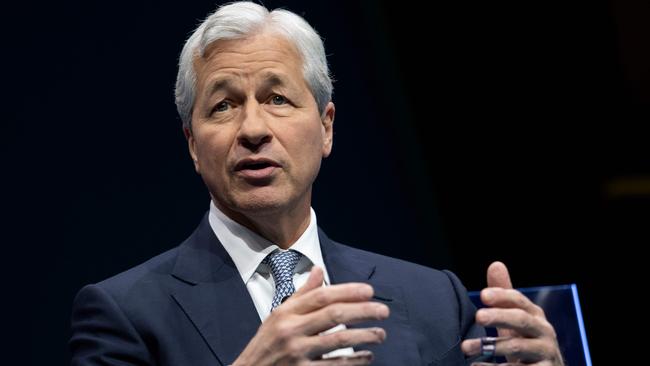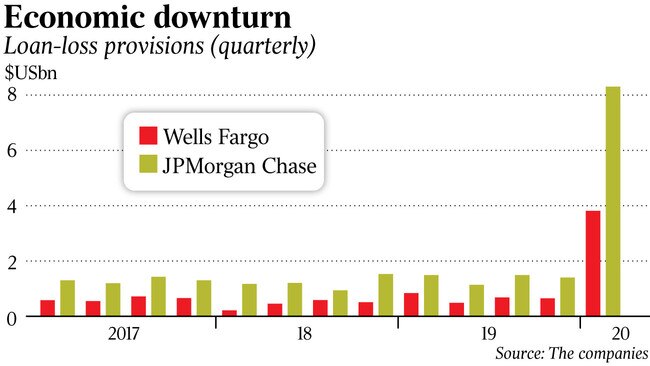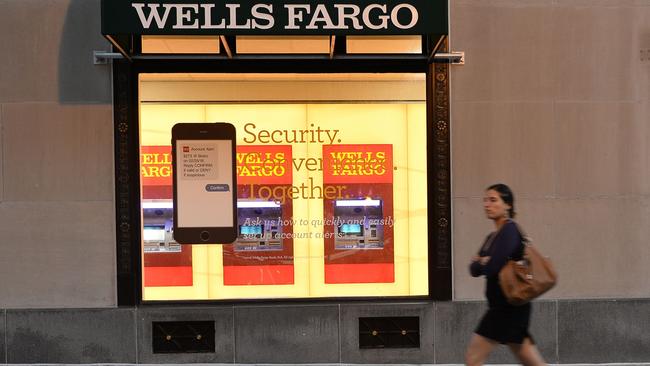JPMorgan Chase, Wells Fargo brace for loan defaults, recession
Big banks have sent a clear message in first-quarter earnings on Tuesday: this recession is going to be bad.

Big banks have sent a clear message in first-quarter earnings on Tuesday: this recession is going to be bad.
JPMorgan Chase and Wells Fargo set aside billions of additional dollars to get ready for a flood of customers to default on their loans as the coronavirus pandemic pummels the economy. That sunk the banks’ quarterly profits.
JPMorgan and Wells Fargo are the first big US banks to report first-quarter results, and act as a bellwether for the broader economy. Neither bank has yet seen a wave of loans go bad, but they are preparing for it as the economy plunges further into a presumed recession and millions remain out of work.
Many Americans were already deep in debt before the pandemic, tapping credit cards, car loans and student loans at record levels to cover a shortfall left by wages that remained flat for many years.
The banks for years rode all that consumer spending and borrowing to big profits. Now, they are preparing to struggle alongside their cash-strapped borrowers. Nearly 17 million Americans have sought unemployment benefits in the past three weeks. About two million homeowners are skipping their monthly mortgage payments, according to industry data.

“This is such a dramatic change of events,” said JPMorgan chief executive James Dimon, who returned to work a few weeks ago after emergency heart surgery. “There are no models that have ever done this.”
JPMorgan set aside an additional $US6.8bn ($10.6bn) in the quarter for potentially bad loans, largely in its consumer bank. That raised its total provision to $US8.29bn, more than the bank has had to take since 2010. But even that may not be enough, the bank warned.
The bank said the provision was based, in part, on the assumption that US gross domestic product would fall an annualised 25 per cent and unemployment would rise to more than 10 per cent in the second quarter. But JPMorgan economists have recently amended their forecast to a 40 per cent decline in GDP in the quarter and a 20 per cent unemployment rate.

Wells Fargo said it set aside an additional roughly $US3bn in the quarter for potentially bad loans, both in the consumer and commercial divisions. That raised its total provision to $US3.83bn. “We don’t know what the time frame is or how quickly the economy will recover,” Wells Fargo CEO Charles Scharf said. “What we do know is the contraction is real.”
Both banks have pledged to help troubled borrowers and small businesses by, for example, waiving late fees or allowing them to temporarily suspend their monthly payments. They have also taken a central role in disbursing government stimulus money to businesses. But that might not be enough for workers who could be out of a job and small businesses that could be shut down for many months.
Spending on credit cards dropped for both banks. JPMorgan said most customers kept up payments on credit cards through to April 1, but that more customers have been late on those loans in the past two weeks. Wells Fargo said consumers had already contacted Wells to defer more than a million payments, mostly on mortgages and auto loans.
What’s more, banks and other lenders are starting to toughen their loan-approval standards, particularly for new customers. That means many people could find it hard to get credit just when they most need it.
JPMorgan earned $US2.87bn, down 69 per cent from $US9.18bn a year earlier. The bank earned US78c a share, missing analysts’ forecast of $US2.16.
JPMorgan revenue was down 3 per cent at $US28.25bn. That fell short of the $US29.55bn analysts had predicted.
Wells Fargo earned $US653m, down 89 per cent from $US5.86bn a year earlier. The bank earned US1c per share, missing analyst expectations of US38c.
Wells Fargo revenue fell 18 per cent to $US17.72bn, missing analyst expectations of $US19.4bn.
Wells Fargo also said it took an impairment charge of $US950m on securities because of the economic and market conditions.
Some banking businesses did surge in the quarter. Corporate clients rushed to load up on cash, drawing down lines of credit from the banks and socking it away in deposit accounts. Both banks posted 6 per cent loan growth, driven by corporate lending.



To join the conversation, please log in. Don't have an account? Register
Join the conversation, you are commenting as Logout